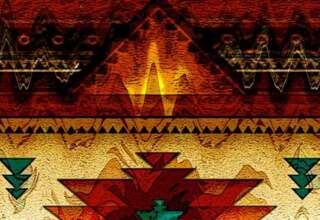
The modern dreamcatcher, adopted by the Pan-Indian Movement and New Age groups, originated in the Ojibwe “spider web charm”, a hoop with woven string or sinew meant to replicate a spider’s web, used as a protective charm for infants. According to Ojibwe legend, the protective charms originate with the Spider Woman, known as Asibikaashi; who takes care of the children and the people on the land and as the Ojibwe Nation spread to the corners of North America it became difficult for Asibikaashi to reach all the children, so the mothers and grandmothers wove webs for the children, which had an apotropaic purpose and were not explicitly connected with dreams.[34]
In Ojibwe tradition, the main task after a death is to bury the body as soon as possible, the very next day or even on the day of death. This was important because it allowed the spirit of the dead to journey to its place of joy and happiness. The land of happiness where the dead reside is called Gaagige Minawaanigozigiwining.[35] This was a journey that took four days. If burial preparations could not be completed the day of the death, guests and medicine men were required to stay with the deceased and the family in order to help mourn, while also singing songs and dancing throughout the night. Once preparations were complete, the body would be placed in an inflexed position with their knees towards their chest. Over the course of the four days it takes the spirit to journey to its place of joy, it is customary to have food kept alongside the grave at all times. A fire is set when the sun sets and is kept going throughout the night. The food is to help feed the spirit over the course of the journey, while the smoke from the fire is a directional guide. Once the four–day journey is over, a feast is held, which is led by the chief medicine man. At the feast, it is the chief medicine man’s duty to give away certain belongings of the deceased. Those who were chosen to receive items from the deceased are required to trade in a new piece of clothing, all of which would be turned into a bundle. The bundle of new cloths and a dish is then given to the closest relative. The recipient of the bundle must then find individuals that he or she believes to be worthy, and pass on one of the new pieces of clothing.
In contemporary times, an Ojibwe spiritual leader from the Mille Lacs Indian Reservation, present day practices follow the same spiritual beliefs and remain fairly similar. When an individual dies, a fire is lit in the home of the family, who are also expected to continuously maintain the fire for four days. Over the four days, food is also offered to the spirit. Added to food offerings, tobacco is also offered as it is considered one of four sacred medicines traditionally used by Ojibwe communities. On the last night of food offerings, a feast is also held by the relatives which ends with a final smoke of the offering tobacco or the tobacco being thrown in the fire. Although conventional caskets are mainly used in today’s communities, birch bark fire matches are buried along with the body as a tool to help light fires to guide their journey to Gaagige Minawaanigozigiwining.
The Ojibwe eat the corms of Sagittaria cuneata for indigestion, and also as a food, eaten boiled fresh, dried or candied with maple sugar. Muskrat and beavers store them in large caches, which they have learned to recognize and appropriate. They take an infusion of the Antennaria howellii ssp. neodioica after childbirth to purge afterbirth and to heal. They use the roots of Solidago rigida, using a decoction of root as an enema and take an infusion of the root for “stoppage of urine”. They use Abies balsamea; melting the gum on warm stones and inhaling the fumes for headache. They also use a decoction of the root as an herbal steam for rheumatic joints. They also combine the gum with bear grease and use it as an ointment for hair. They use the needle-like leaves in as part of ceremony involving the sweat bath and use the gum for colds and inhale the leaf smoke for colds.






